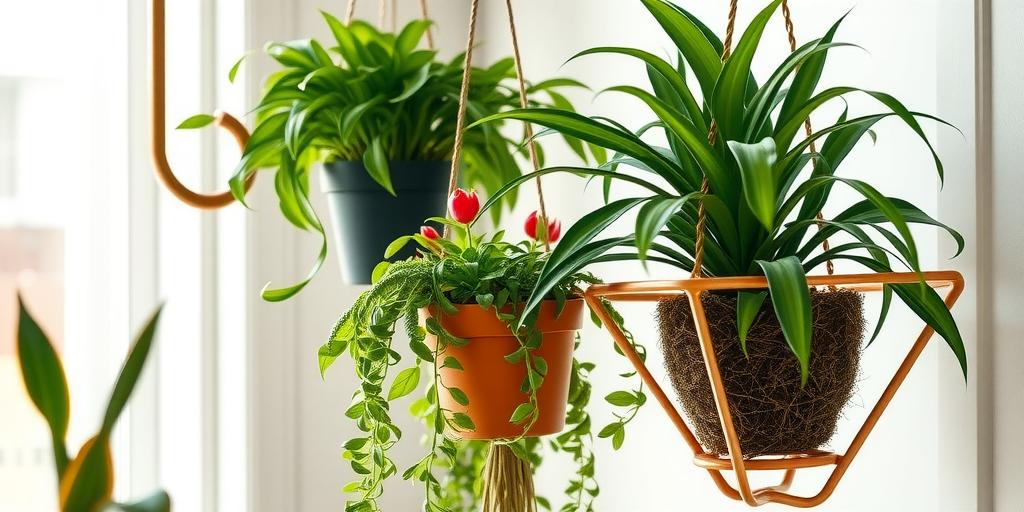
Maximize Your Space: Hanging Plants For Small Spaces (2025 Guide)
Discover the best hanging plants for small spaces to maximize your home’s greenery without sacrificing floor space! Get expert tips on plant selection, care, and creative display ideas.
Introduction
Tight on space but craving a lush, green oasis? You’re not alone! Studies show that indoor plants can boost mood, purify air, and even increase productivity—but what if you don’t have room for large pots? That’s where hanging plants come in! Whether you’re in a tiny apartment or just looking to add vertical interest, this guide will help you choose, style, and care for the best hanging plants for small spaces. Let’s turn those bare walls and ceilings into a thriving indoor jungle!
Why Choose Hanging Plants for Small Spaces?
Space-Saving Benefits
One of the biggest advantages of hanging plants is how they free up valuable floor and shelf space. If you live in a tiny apartment or have limited surfaces for decor, hanging plants let you bring in greenery without cluttering your home. Instead of crowding your windowsill with pots, you can suspend them from the ceiling or walls, keeping your space open and airy.
Improved Air Circulation
Hanging plants don’t just look good—they can also help with airflow. When placed near windows or in corners, they encourage better air movement, preventing stagnant pockets of air. Some plants, like spider plants and pothos, even help purify the air, making your small space feel fresher.
Aesthetic Appeal
There’s something magical about trailing vines and cascading leaves. Hanging plants add depth and texture to a room, drawing the eye upward and making ceilings feel higher. Whether you prefer lush ferns or delicate strings of pearls, these plants create a dynamic, layered look that floor-bound plants just can’t match.
Versatility
Hanging plants work in almost any space—apartments, balconies, bathrooms, even kitchens. You can hang them in bright, sunny spots or tuck them into dimmer corners with low-light varieties. Their adaptability makes them perfect for renters or anyone who likes to rearrange their decor frequently.
Best Hanging Plants for Small Spaces (Low-Maintenance Picks)
Pothos (Devil’s Ivy)
If you’re new to plants or just want something nearly indestructible, pothos is a top choice. It thrives in low light, forgives missed waterings, and grows quickly, making it ideal for hanging baskets where its vines can spill over beautifully.
Spider Plant
Spider plants are practically foolproof. They tolerate a range of light conditions, produce adorable baby offshoots (called “spiderettes”), and are safe for pets. Their arching leaves look fantastic in hanging planters, especially in bright, indirect light.
String of Pearls
For a touch of whimsy, try a string of pearls. This succulent has trailing stems dotted with small, bead-like leaves. It loves bright light and infrequent watering, making it perfect for sunny windowsills or well-lit bathrooms.
Philodendron Heartleaf
Another easy-care option, the heartleaf philodendron, has glossy, heart-shaped leaves that trail elegantly. It adapts well to different light levels and grows quickly, filling out a hanging basket in no time.
Ferns (Boston, Maidenhair)
Ferns bring lush, feathery texture to hanging displays. Boston ferns are hardy and great for beginners, while maidenhair ferns (though a bit fussier) thrive in humid spots like bathrooms. Just keep their soil consistently moist, and they’ll reward you with vibrant growth.
Creative Ways to Hang Plants in Small Areas
Macramé Hangers
Macramé plant hangers add a cozy, bohemian vibe to any space. They’re perfect for suspending plants near windows or in empty corners, and they come in endless styles—from minimalist to intricately knotted designs.
Wall-Mounted Planters
Don’t have ceiling space? Wall-mounted planters let you turn blank walls into vertical gardens. Mix and match different sizes for a gallery-wall effect, or use a single statement piece as a focal point.
Ceiling Hooks & Tension Rods
Renters, rejoice! You don’t need to drill holes to hang plants. Sturdy adhesive hooks or tension rods (placed in doorways or between walls) can support lightweight planters without damaging your space.
Floating Shelves with Trailing Plants
Combine function and beauty by placing trailing plants on floating shelves. The vines will spill downward, softening the edges and adding life to your storage solutions.
Over-the-Door Hangers
Maximize every inch of space by using over-the-door hooks for hanging plants. They’re great for small herb gardens in the kitchen or for adding greenery to a closet door.
Essential Care Tips for Hanging Plants
Watering Hacks
Hanging plants can be tricky to water without making a mess. Try self-watering globes or lightweight plastic pots with drainage holes to prevent spills. Always check the soil before watering—overhead baskets dry out faster than ground-level pots.
Light Requirements
Match your plants to your home’s natural light. Low-light plants like pothos and philodendrons do well in dimmer spots, while succulents and spider plants need brighter indirect light. Rotate hanging plants occasionally to ensure even growth.
Pruning & Maintenance
Keep trailing plants looking their best by trimming leggy vines and removing dead leaves. Regular pruning encourages bushier growth and prevents plants from becoming too heavy for their hangers.
Fertilizing Schedule
Hanging plants benefit from occasional feeding, especially during the growing season. Use a balanced liquid fertilizer every 4–6 weeks, but dilute it slightly to avoid overfeeding.
Common Mistakes to Avoid with Hanging Plants
Overwatering or Underwatering
It’s easy to forget about hanging plants—or to overcompensate with too much water. Check the soil regularly; if the top inch is dry, it’s time to water. Succulents and ferns have very different needs, so tailor your routine to each plant.
Choosing Plants That Outgrow Their Space
Some trailing plants, like certain ivy varieties, grow aggressively. If you have limited space, opt for slower growers or be prepared to trim frequently to keep them in check.
Ignoring Weight Limits
Not all hooks or hangers can support heavy plants. Always check weight ratings before hanging, especially if using adhesive hooks or tension rods. A falling planter can damage floors—or worse, injure someone.
Placing Sun-Loving Plants in Dark Corners
A sun-starved succulent or flowering plant won’t thrive in a dim corner. Be honest about your light conditions and choose plants that will actually flourish in your space. If you love a high-light plant but don’t have the right spot, consider using a grow light.
Conclusion
Hanging plants are the ultimate solution for small-space dwellers who want to bring nature indoors without clutter. From low-maintenance pothos to elegant string of pearls, there’s a perfect plant for every corner. With the right care and creative display, you can transform even the tiniest apartment into a lush retreat. Ready to start? Pick your favorite trailing plant, grab a stylish hanger, and let your greenery take flight!
